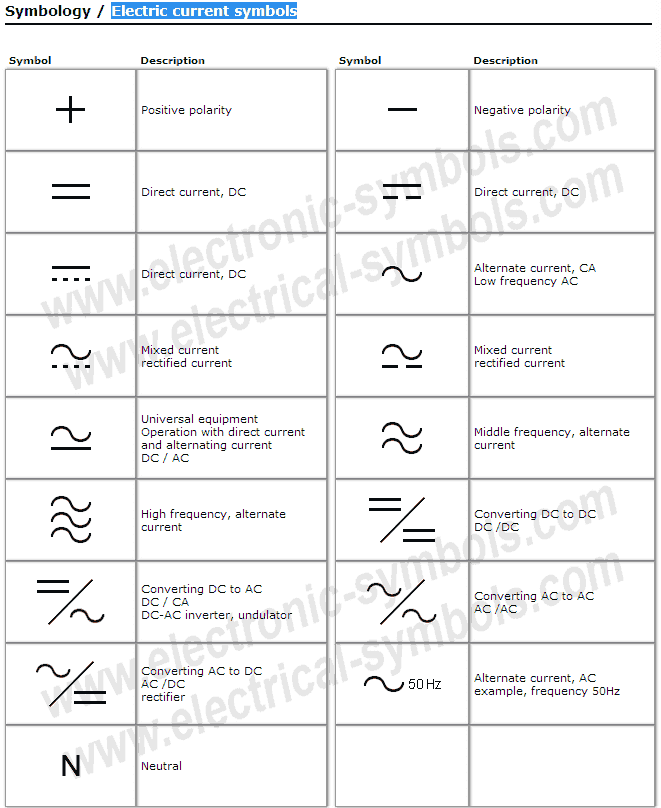Decoding the Secrets of AC and DC Current Symbols
Ever wondered about those squiggly lines and dashed lines you see on electrical diagrams? They're not just random doodles; they represent the flow of electrical current, specifically alternating current (AC) and direct current (DC). Understanding these symbols is fundamental to navigating the world of electronics, from simple household appliances to complex industrial machinery.
These seemingly simple markings hold a wealth of information, acting as a universal language for electrical engineers and technicians. They convey the type of current flowing through a circuit, enabling clear communication and preventing potentially disastrous misinterpretations. Imagine the chaos if there weren't standardized symbols for such crucial information!
The AC symbol, often depicted as a sinusoidal wave (~), represents the constantly changing direction of current flow. This type of current is what powers our homes and businesses, delivered through power lines from generating stations. The DC symbol, typically a straight line with a dashed line underneath (⎓) or sometimes just a straight line, signifies a constant flow of current in a single direction, commonly found in batteries and electronic devices.
The history of these symbols is intertwined with the development of electricity itself. As scientists and engineers experimented with different forms of electrical current, the need for a standardized way to represent them became evident. These symbols evolved over time, becoming refined and universally adopted to ensure clarity and prevent confusion.
The importance of these symbols cannot be overstated. They are essential for designing, building, and troubleshooting electrical circuits. They enable engineers to communicate complex electrical concepts efficiently and effectively, ensuring that everyone involved in a project is on the same page. Misinterpreting these symbols could lead to faulty designs, malfunctioning equipment, or even dangerous electrical hazards.
The AC symbol signifies alternating current, where the flow of electrons periodically reverses direction. Think of the current flowing back and forth like a pendulum swinging. DC, on the other hand, represents direct current, a unidirectional flow of electrons, like water flowing down a river.
One key difference between AC and DC lies in their application. AC is commonly used for power transmission over long distances due to its efficiency in transforming voltage levels. DC is preferred for electronic devices and battery-powered systems as it provides a stable and consistent power source.
Understanding the difference between AC and DC designations is crucial for safety. Connecting a DC device to an AC power source, or vice versa, can lead to damage or even create hazardous situations. The symbols are essential warnings, guiding users to connect devices to the appropriate power supply.
Benefits of using standardized AC/DC symbols: Enhanced communication, improved safety, simplified circuit design.
Recommendations: Consult electrical engineering textbooks for detailed information on AC and DC principles. Several online resources and apps offer interactive simulations and explanations of electrical circuits.
Advantages and Disadvantages of Standardized Symbols
The following FAQ addresses commonly asked questions about AC/DC symbols:
1. What is the difference between AC and DC? AC alternates direction, while DC flows in one direction.
2. Why are different symbols used? The symbols visually distinguish the different types of current.
3. Where can I learn more about these symbols? Electrical engineering textbooks and online resources provide detailed explanations.
4. Are there variations in the symbols? Yes, minor stylistic variations can occur but the core representation remains consistent.
5. Why is understanding these symbols important? They are crucial for safety and effective communication in electrical work.
6. Can I use these symbols interchangeably? No, using the wrong symbol can lead to dangerous misconnections.
7. How are these symbols used in circuit diagrams? They indicate the type of current flowing through different parts of the circuit.
8. Are there any tools to help me understand these symbols better? Yes, educational apps and software can offer interactive simulations and examples.Tips and Tricks: Pay close attention to the symbols on electrical devices and power sources. When in doubt, consult an electrician or qualified professional for guidance. Understanding these symbols is essential for working safely with electricity.
In conclusion, the symbols for alternating current (AC) and direct current (DC) are fundamental to the world of electricity. These simple markings convey crucial information about the type of current flowing in a circuit, enabling clear communication and safe practices among electrical professionals. From powering our homes to running our electronic devices, understanding these symbols is essential for navigating the electrical landscape. By appreciating the history, meaning, and importance of these symbols, we can foster a safer and more efficient use of electricity in our daily lives. Take the time to familiarize yourself with these symbols and continue exploring the fascinating world of electrical engineering. Your knowledge will empower you to interact safely and effectively with the electrical systems that surround us, ensuring a brighter and more connected future.
Reaching your limit understanding tying the knot at the end of your rope
Unlocking math success your guide to soalan ppt matematik tahun 5
Unlocking usaa credit cards your guide to credit score requirements

symbols for ac and dc current | Innovate Stamford Now

How to Use a Multimeter to Measure Voltage Current and Resistance | Innovate Stamford Now

Ac Dc Power Supply Symbol | Innovate Stamford Now

Schematic Symbol For Dc Power Supply | Innovate Stamford Now

How to Use a Multimeter for Electronics Projects | Innovate Stamford Now

Learn the meaning function and usage of multimeter symbols with this | Innovate Stamford Now

Actron Cp7672 Features Chart Digital Multimeter Revised 55 OFF | Innovate Stamford Now
symbols for ac and dc current | Innovate Stamford Now

Voltage Symbols Ac Dc | Innovate Stamford Now

Power Source Schematic Symbol | Innovate Stamford Now

Símbolos Electrónicos Electric current symbols | Innovate Stamford Now

Direct and alternating current dc and ac symbol Vector Image | Innovate Stamford Now

AC and DC Symbols Electric Current Symbols | Innovate Stamford Now

symbols for ac and dc current | Innovate Stamford Now

symbols for ac and dc current | Innovate Stamford Now